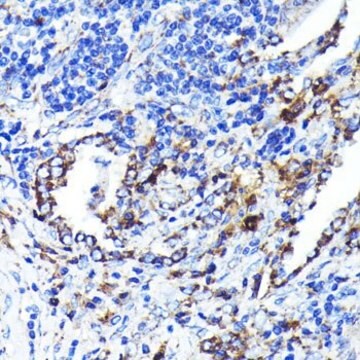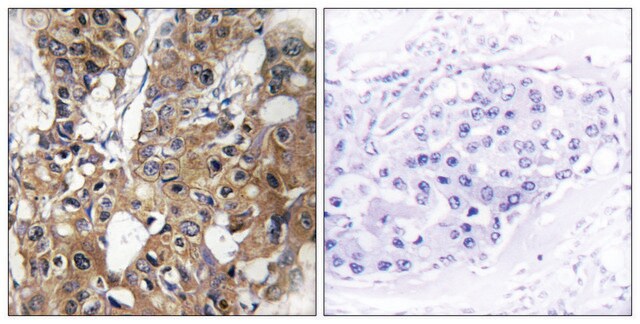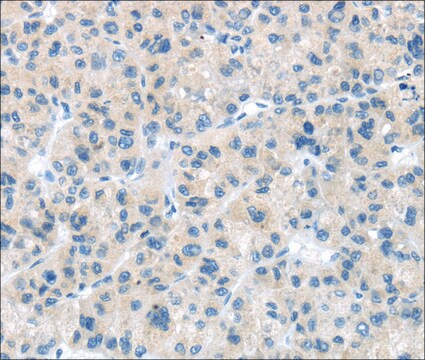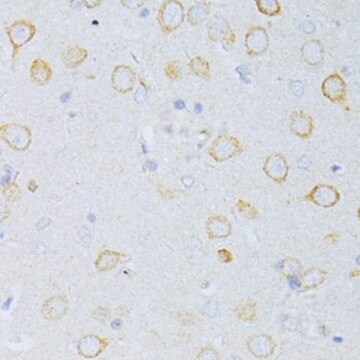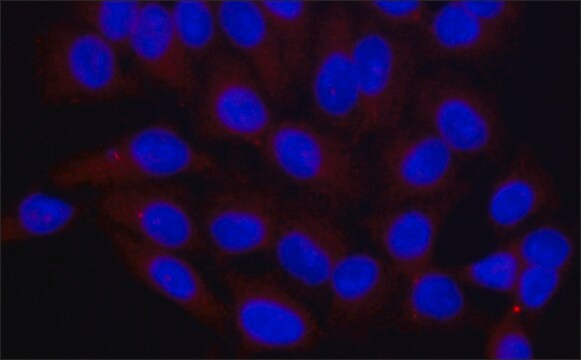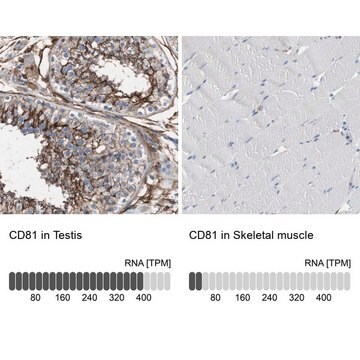推薦產品
生物源
rabbit
共軛
unconjugated
抗體表格
affinity isolated antibody
抗體產品種類
primary antibodies
無性繁殖
polyclonal
形狀
buffered aqueous solution
分子量
antigen ~25 kDa
物種活性
human, mouse, rat
濃度
~1 mg/mL
技術
immunohistochemistry: 1:100-1:250
western blot: 1:500-1:1,000
UniProt登錄號
運輸包裝
dry ice
儲存溫度
−20°C
目標翻譯後修改
unmodified
基因資訊
human ... CD9(928)
mouse ... Cd9(12527)
rat ... Cd9(24936)
一般說明
CD9是一种富含胶质瘤干细胞(GSC)的蛋白质,属于四跨膜蛋白(tetraspanin)家族。它是一种与细胞运动相关的分子。基因位于人染色体12p13.31上。CD9在前B细胞、活化T细胞和施旺细胞中表达。
免疫原
对应于人CD9残基36-50的合成肽。
應用
从兔中生产的抗CD9抗体可用于
- 免疫染色
- 缺氧诱导的间充质干细胞(MSC-MVs)的鉴定
兔抗CD9抗体适用于免疫组织化学(工作稀释度为1:100-1:250)和蛋白质印迹分析(工作稀释度为1:500-1:1000)。在研究粘附蛋白对骨骼肌成肌细胞分化的影响的研究过程中,它被用作粘附蛋白CD9免疫定位的一抗。
生化/生理作用
CD9 在受精过程的精卵融合中发挥主要作用。在宫颈癌、胃癌和成胶质细胞瘤(GBM)中,它促进癌症侵袭和肿瘤生长。CD9与细胞侵袭、细胞凋亡和化疗耐药性有关。
標靶描述
CD9蛋白是一种细胞表面糖蛋白,其已知可与整联蛋白和其他跨膜4超家族蛋白进行复合。它可以调节细胞粘附和迁移。它还可触发血小板激活和聚集。另外,该蛋白可能能够促进肌肉细胞融合并支持肌管维持。
外觀
溶于含有 0.02% 叠氮化钠的磷酸盐缓冲液中。
免責聲明
除非我们的产品目录或产品附带的其他公司文档另有说明,否则我们的产品仅供研究使用,不得用于任何其他目的,包括但不限于未经授权的商业用途、体外诊断用途、离体或体内治疗用途或任何类型的消费或应用于人类或动物。
未找到適合的產品?
試用我們的產品選擇工具.
儲存類別代碼
10 - Combustible liquids
閃點(°F)
Not applicable
閃點(°C)
Not applicable
個人防護裝備
Eyeshields, Gloves, multi-purpose combination respirator cartridge (US)
分析證明 (COA)
輸入產品批次/批號來搜索 分析證明 (COA)。在產品’s標籤上找到批次和批號,寫有 ‘Lot’或‘Batch’.。
客戶也查看了
Retinoic acid represses a cassette of candidate pluripotency chromosome 12p genes during induced loss of human embryonal carcinoma tumorigenicity
Giuliano CJ, et al.
Biochimica et Biophysica Acta (BBA)-Gene Structure and Expression, 1731(1), 48-56 (2005)
CD9 suppresses human extravillous trophoblast invasion
Matsumoto H, et al.
Placenta, 47(1), 105-112 (2016)
Competence of in vitro cultured mouse embryonic stem cells for myogenic differentiation and fusion with myoblasts
Archacka K, et al.
Stem Cells and Development, 23(20), 2455-2468 (2014)
Karolina Archacka et al.
Stem cells and development, 23(20), 2455-2468 (2014-06-19)
Pluripotent stem cells are a potential source of various cell types for use in regenerative medicine. Despite accumulating knowledge, there is currently no efficient and reproducible protocol that does not require genetic manipulation for generation of myogenic cells from pluripotent
Mallory E Harden et al.
Virology, 508, 63-69 (2017-05-14)
Extracellular vesicles released by cancer cells are mediators of intercellular communication that have been reported to contribute to carcinogenesis. Since they are readily detected in bodily fluids, they may also be used as cancer biomarkers. The E6/E7 oncoproteins drive human
我們的科學家團隊在所有研究領域都有豐富的經驗,包括生命科學、材料科學、化學合成、色譜、分析等.
聯絡技術服務